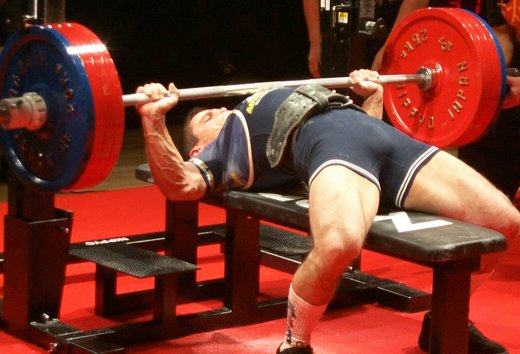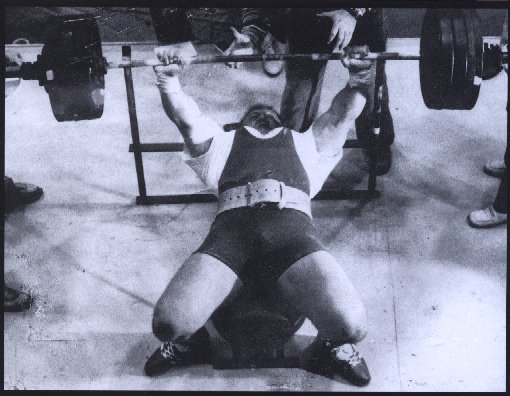

What is the Bench Press?
The Bench Press (right) is a simple but effective exercise that builds strength in the chest, shoulders, and arms. It is probably the most popular and well known exercise in weightlifting. It is also very effective because it works more than one muscle group.
How do you the Bench Press?
The Bench Press is performed lying on your back on a flat bench. Position your hands on the bar a little wider than shoulder width apart. Lift the weight from the rack and position it above your chest. Lower the weight to your chest, right above your ribs and let it touch lightly. Immediately push the weight back to its starting position. The most important things to remember when benching are to always have a good spotter and never bounce the weight off your chest. Also remember to keep your wrists straight and rigid.

The Physics of the Bench Press
Much like the Squat, the factor that makes the Bench Press so effective is the push directly against the downward pull of gravity. The same laws of Physics applied to the Squat on the previous page can be applied here as well. But there are other concepts that can be applied to both lifts.
One such concept is the concept of work. This is not work in the sense that most people know. Work can be defined as:
Work W done on an object by an agent exerting a constant force on the object is the product of the component of the force in the direction of the displacement and the magnitude of the displacement.
In equation form : Fd cos(x) where F=the applied force, d=displacement, and x=the angle the force acts at.
For example, take the man benching in the picture below. He applies a force of 2500 N on the weight and displaces the weight .5 meters. How much work did he do on the weights?
 (www.roxboro.net)
(www.roxboro.net)
The force applied is 2500 N and the displacement is .5 m. Since the force is in the direction of the displacement, the angle is 0 degrees and COs(0) =1 so
FD=2500 N * .5m = 1250N*m
The Newton-meter is used so much that it has been given the name Joule(J), so the Work done by the man is 1250 J.
Another physical concept that can be applied to the bench press is power. Power in the physical sense can be defined as work over time or:
Power P =Work(W)/Time interval(T)
It takes the man in the picture 2 seconds to raise the bar from his chest to his initial position(.5 meters). From the last question, we know that the work done by the lifter is 1250 J. If the time interval is 2 seconds, then:
P = 1250J/2s = 625 J/s
Joules per second are also known as watts (W), so the total power of the lifter is 625 W.







How much can you bench?
The current world record in the bench press is 805 pounds, held by Anthony Clark.


